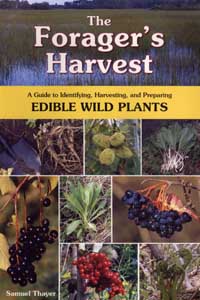
Questions about Edible Wild Plants
with replies by Thomas J. Elpel, author of Botany in a Day
We spend a lot of time answering e-mail questions. Some of them we answer again and again, so this page is the start of a FAQ's column to hopefully provide meaningful answers without having to rewrite them all the time. We'll add much more to this page as we go along. If you e-mail a question to us, please let us know if we can use your letter on the website. Also, be prepared to wait a week or two or sometimes much longer (especially in summer) for a reply as we have a lot of distractions already, and sometimes it is really difficult to keep up with all the e-mails.
Questions:
Are rose hip seeds poisonous?
Hi Thomas,
I was just reading the section of Botany in a Day on Rosaceae, the Rose Family. I was surprised when I read that the seeds of rosehips should be eaten. I've always been told (by at least one well-renowned primitive skills instructor) that they are inedible or even poisonous. If I remember correctly, they contain high concentrations of oxalic acid. Have I been misinformed? Could it be possible that some species have edible seeds while others are poisonous?
Seed-eatin' with caution,
Rob
Rob,
Thanks for writing. In twenty years I've never come across any reference to the seeds of rose hips being poisonous, except that they are hairy and could potentially become a choking hazard.
 Certainly, there are regional variations in plants, so it is remotely possible that rosehip seeds in your area are poisonous. More likely it is a myth that has been passed down by word of mouth.
Certainly, there are regional variations in plants, so it is remotely possible that rosehip seeds in your area are poisonous. More likely it is a myth that has been passed down by word of mouth.
I always heard within my family that hollyhocks (Mallow Family) were poisonous, but upon investigation I found nothing in the literature to suggest that they were. In this case, I speculate that there was uncertainty, and uncertainty led to fear of the plant, which led my family to assume that it was poisonous--a myth that was then passed down from generation to generation.
Interestingly, the tomato (Nighshade Family) was assumed to be poisonous when it was first brought back to Europe from the New World, since most of its relatives were known to be poisonous. People grew tomatoes for years strictly as ornamentals before anyone realized they were edible.
In any case, I commend you for being cautious and doing some research into your concerns. It never hurts to gather additional information.
Sincerely,
Thomas J. Elpel
Are pine nuts edible raw from the cone?
Can you eat pinion nuts raw from the pine cone and what do you look for in an edible pinion nut? Does it have to have a certain color? Is the pinion tree sap poisonous?
thank you,
Carlos
Carlos,
Thanks for writing. All pines produce edible nuts, though some are small or nearly impossible to extract from the cones. Pinion pines from the southwest are best known for their large and edible nuts. Here in Montana we harvest pinenuts mostly from the whitebark pines high up in the mountains as they ripen in October.
As the pinenuts reach full maturity the cones dry out and gradually open up until the nuts fall to the ground. The pinenuts taste best when fully mature, but they are edible when green too.
 To extract pinenuts from the green cones, first make a ring of the cones around your campfire to help dry them enough so that they will begin to open on their own. Then pry the scales back with your fingers to free the pinenuts. Expect to become a pitchy mess in the process.
To extract pinenuts from the green cones, first make a ring of the cones around your campfire to help dry them enough so that they will begin to open on their own. Then pry the scales back with your fingers to free the pinenuts. Expect to become a pitchy mess in the process.
the pitchy cones) but usually not too bad. The pitch is basically harmless, although excess consumption of resinous substances can potentially irritate or plug the tubules of the kidneys. It shouldn't be a problem unless you consume a lot of pitch over an extended period.
The hull is usually processed off the pinion nuts, but ours are quite edible with the hull intact. You can eat the pinenuts whole or ground, and raw or cooked. They are delicious in any form. I like to grab a few cones and extract the nuts as I walk, eating them one-at-a-time as I travel.
I don't have much experience with pinion pines, but the season for our whitebark pinenut is relatively short. The squirrels cut the cones from the trees as fast as they can and cache them in a million different holes. The Clark's nutcracker plants the nuts in little holes all over the mountains, which is one of the main ways the trees regenerate. Bears eat the pine nuts by the thousands. Soon, all that is left is empty cones, or a few infertile, dried-out pine nuts, but you can extend the season a bit by raiding the squirrel caches. Don't worry about taking some of their food; the squirrels horde the pine cones like gold and cache far more than they need.
I hope this helps!
Sincerely,
Thomas J. Elpel
Be sure to a look at Sam Thayer's book:
The Forager's Harvest: A Guide to Identifying, Harvesting, and Preparing Edible Wild Plants
Also be sure to see Botany in a Day: The Patterns Method of Plant Identification





 Wildflowers-and-Weeds.com
Wildflowers-and-Weeds.com 






